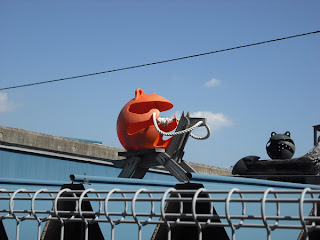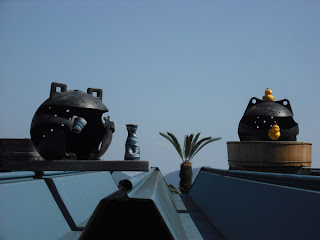...figures in transient space...
Transfiguration, a retrospective by Japanese artist Leiko Ikemura, was exhibited at The National Museum of Modern Art (Tokyo). I went there on a whim, so I didn't know anything about this artist before.
The experience was normal. There were a few works that really stuck out, but I wasn't awed to the floor. I didn't think any of it was bad; I guess it just wasn't to my liking. Seeing art is a bit like falling in love; it strikes chords in your heart, usually inexplicable, and just draws you in. I didn't have that feeling this time, but I did appreciate her technical skill, along with her cohesive working theme.
Her paintings were of beautiful quality, in terms of materials. It was perhaps the subject matter that I simply didn't care about, but the paint itself was gorgeous. I stood for a long time, looking at Red Trees. I loved how she used jute instead of regular canvas; that raw feeling, soaked in that lush red, almost like pulsating blood, was indeed a sight to marvel at. It also felt strangely meditative, but this was perhaps due to the room it was located in.
That room also housed a series of her sculptures, these creepy busts of indistinct portraits. They stood behind a glass on the left side, and they were mirrored by writing on the opposite olive green wall. The text was all in Japanese, so I couldn't read it, but there was a translation on the furthest wall before leaving the room. It spoke about a tale that was later revealed as a dream. I must admit, with the serene yet creepy sound playing in the background, it was undeniably an interesting feeling. This was perhaps the most thought-provoking room of the exhibit.
I'm not a sculptor, so I can't really comment on them. But I thought it was pretty amazing to be able to paint and sculpt, while keeping their aethetics very similar. Ikemura's graps of these two disciplines really complimented eachother, and it seemed like her oeuvre worked best when they co-existed.
While searching for the images above (because we can never take photos inside the gallery!), I found these awesome drawings/watercolours that I'd like to share. They weren't exibited, but I'm sure if I saw them, I'd be drawn in.
Conclusion
The retrospective wasn't mind-blowing, but there were certainly pieces to marvel over. It was good to learn about a new artist, and see her progression throughout the years.
Tranfiguration by Leiko Ikemura was held at Tokyo's National Museum of Modern Art, from August 23rd to October 23rd, 2011.
Sunday, 20 November 2011
Saturday, 19 November 2011
Film Review: 好きだ (Su-ki-da)
... the long way to love...
Sukida (2005) is very difficult to pin in words. For one, there's hardly any dialogue in the film, and it's one of those things that you really need to watch in order to judge for yourself. If someone overanalyses it, it'll probably ruin the experience.
After watching the film for the 4th time, I can truly say that I love it. There were a few things that irked me (and I can see critics pointing out those bits), but overall, the experience was great so I let them slide. This film is really not for everyone, but if it touches you, it REALLY does... (or at least in my case, lol)
It's also not readily available in North America: I purchased a copy on CDJapan. There were english subtitles (and french too!) but the region code didn't work on a normal DVD player, so I had to switch the region on my computer. A bit of a hassle, but after paying over 50$ for the film, I was pretty determined to watch it.
If I were to describe it, I'd say it's... sensitive. Once again, words won't do it justice, so here are screenshots from beginning to end:
Conclusion
I think a film is successful when it's able to evoke some change in their viewer's life. Sukida triggered something in me, and I send my gratitude to Ishikawa Hiroshi, the director of this film. This review hasn't been very informative or critical: one could say it's as cryptic as this film! You simply have to watch it for yourself to see if you will end up saying I love you.
Sukida (2005) is very difficult to pin in words. For one, there's hardly any dialogue in the film, and it's one of those things that you really need to watch in order to judge for yourself. If someone overanalyses it, it'll probably ruin the experience.
After watching the film for the 4th time, I can truly say that I love it. There were a few things that irked me (and I can see critics pointing out those bits), but overall, the experience was great so I let them slide. This film is really not for everyone, but if it touches you, it REALLY does... (or at least in my case, lol)
It's also not readily available in North America: I purchased a copy on CDJapan. There were english subtitles (and french too!) but the region code didn't work on a normal DVD player, so I had to switch the region on my computer. A bit of a hassle, but after paying over 50$ for the film, I was pretty determined to watch it.
If I were to describe it, I'd say it's... sensitive. Once again, words won't do it justice, so here are screenshots from beginning to end:
Conclusion
I think a film is successful when it's able to evoke some change in their viewer's life. Sukida triggered something in me, and I send my gratitude to Ishikawa Hiroshi, the director of this film. This review hasn't been very informative or critical: one could say it's as cryptic as this film! You simply have to watch it for yourself to see if you will end up saying I love you.
Thursday, 3 November 2011
Photo Impression: Naoshima, Kagawa-ken, Japan
If this blog entry has piqued your curiosity, don't hesitate to contact me and I can give you instructions on how to get there. It's kind of in a remote area where normal tourists don't usually go. But if you're headed to Japan and you like art, it's REALLY worth it.
Subscribe to:
Comments (Atom)
























































